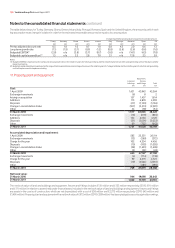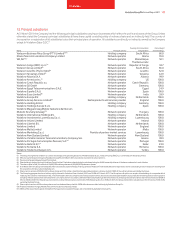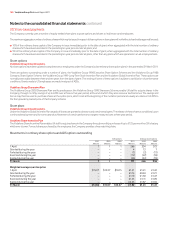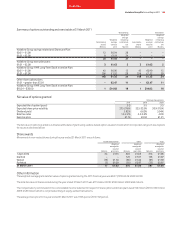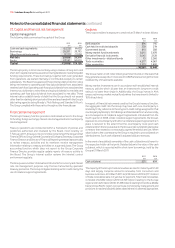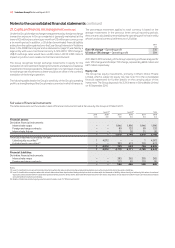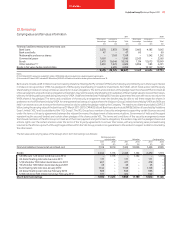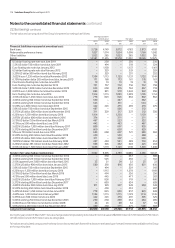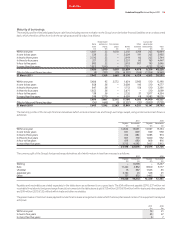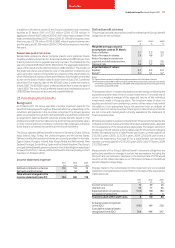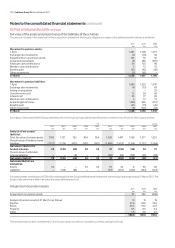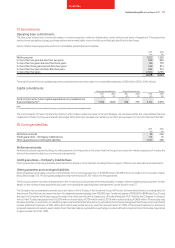Vodafone 2011 Annual Report Download - page 113
Download and view the complete annual report
Please find page 113 of the 2011 Vodafone annual report below. You can navigate through the pages in the report by either clicking on the pages listed below, or by using the keyword search tool below to find specific information within the annual report.
Vodafone Group Plc Annual Report 2011 111
Financials
Market risk
Interest rate management
Under the Group’s interest rate management policy, interest rates on
monetary assets and liabilities denominated in euros, US dollars and sterling
are maintained on a floating rate basis except for periods up to six years where
interest rate fixing has to be undertaken in accordance with treasury policy.
Where assets and liabilities are denominated in other currencies interest rates
may also be fixed. In addition, fixing is undertaken for longer periods when
interest rates are statistically low.
At 31 March 2011 71% (2010: 36%) of the Group’s gross borrowings were fixed
for a period of at least one year. For each one hundred basis point fall or rise
in market interest rates for all currencies in which the Group had borrowings
at 31 March 2011 there would be a reduction or increase in profit before tax
by approximately £30 million (2010: increase or reduce by £165 million)
including mark-to-market revaluations of interest rate and other derivatives
and the potential interest on outstanding tax issues. There would be no
material impact on equity.
Foreign exchange management
As Vodafone’s primary listing is on the London Stock Exchange its share price
is quoted in sterling. Since the sterling share price represents the value of its
future multi-currency cash flows, principally in euro, US dollars and sterling,
the Group maintains the currency of debt and interest charges in proportion
to its expected future principal multi-currency cash flows and has a policy to
hedge external foreign exchange risks on transactions denominated in other
currencies above certain de minimis levels. As the Group’s future cash flows
are increasingly likely to be derived from emerging markets it is likely that
more debt in emerging market currencies will be drawn.
As such, at 31 March 2011 130% of net debt was denominated in currencies
other than sterling (55% euro, 47% US dollar and 28% other) while 30% of net
debt had been purchased forward in sterling in anticipation of sterling
denominated shareholder returns via dividends and share buybacks. This
allows euro, US dollar and other debt to be serviced in proportion to expected
future cash flows and therefore provides a partial hedge against income
statement translation exposure, as interest costs will be denominated in
foreign currencies. Yen debt is used as a hedge against the value of yen assets
as the Group has minimal yen cash flows.
The following table presents ageing of receivables that are past due and
are presented net of provisions for doubtful receivables that have
been established.
2011 2010
£m £m
30 days or less 1,561 1,499
Between 31 – 60 days 100 119
Between 61 – 180 days 85 155
Greater than 180 days 298 183
2,044 1,956
Concentrations of credit risk with respect to trade receivables are limited
given that the Group’s customer base is large and unrelated. Due to this
management believes there is no further credit risk provision required in
excess of the normal provision for bad and doubtful receivables. Amounts
charged to administrative expenses during the year ended 31 March 2011
were £460 million (2010: £465 million, 2009: £423 million) (see note 17).
The Group’s investments in preferred equity and a subordinated loan
received as part of the disposal of Vodafone Japan to SoftBank in the 2007
financial year were disposed of during the year. The Group has a receivable
of £1,488 million (2010: £nil) in relation to the second tranche of
consideration receivable in relation to the disposal.
As discussed in note 28 the Group has covenanted to provide security in
favour of the Trustee of the Vodafone Group UK Pension Scheme in respect
of the funding deficit in the scheme. The security takes the form of an
English law pledge over UK index linked government bonds.
Liquidity risk
At 31 March 2011 the Group had €4.2 billion and US$4.2 billion syndicated
committed undrawn bank facilities and US$15 billion and £5 billion
commercial paper programmes, supported by the €4.2 billion and
US$4.2 billion syndicated committed bank facilities, available to manage
its liquidity. The Group uses commercial paper and bank facilities to
manage short-term liquidity and manages long-term liquidity by raising
funds in the capital markets.
€4.2 billion of the syndicated committed facility has a maturity date of 1 July
2015 and US$4.2 billion has a maturity of 9 March 2016 which may be
extended by a further year if agreed by those banks who have participated
in the facility. Both facilities have remained undrawn throughout the
financial year and since year end and provide liquidity support.
The Group manages liquidity risk on long-term borrowings by maintaining
a varied maturity profile with a cap on the level of debt maturing in any one
calendar year, therefore minimising refinancing risk. Long-term borrowings
mature between one and 26 years.
Liquidity is reviewed daily on at least a 12 month rolling basis and stress
tested on the assumption that all commercial paper outstanding matures
and is not reissued. The Group maintains substantial cash and cash
equivalents which at 31 March 2011 amounted to £6,252 million (2010:
£4,423 million).



